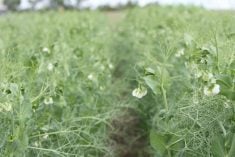A respected farm consultant thinks there’s an extra 3.3 million tonnes of canola in the countryside that hasn’t been accounted for.
Phil Thomas, with Agri-Trend Agrology Ltd., has spoken to too many farmers and clients with yields in the 65 to 80 bushel per acre range to put much faith in the average yield figure of 30.7 bu. found in Agriculture Canada’s October supply and disposition report.
“When you average the whole of Western Canada, I wouldn’t be at all surprised if we’re coming awful close to 40,” said Thomas during a break at the Agri-Trend 2008 Farm Forum Event.
Read Also

Phosphate prices to remain high
Phosphate prices are expected to remain elevated, according to Mosaic’s president.
Multiplying the former Alberta Agriculture provincial oilseed specialist’s yield number by Agriculture Canada’s harvested acreage number results in a 14.2 million tonne canola crop, dwarfing the October 10.9 million tonne estimate.
A representative of a canola buyer, who asked not to be identified, took issue with Thomas’s forecast.
“That is pretty extreme. I would say there is nobody out there in the trade that has got anywhere near that kind of number,” said the trader with a large oilseed processing firm.
The previous average yield record for canola was 30.7 bu. per acre set in 2006-07.
“To be 10 bu. an acre higher, that’s a pretty big stretch,” he said.
But the trader agreed that Agriculture Canada’s number is “way too low.” His firm is projecting a little over 12 million tonnes based on an average yield of 35 bu. per acre. His colleagues have similar estimates.
Statistics Canada releases a production report Dec. 4 that many in the trade expect will show a 12 to 12.5 million tonne crop.
“That’s pretty reasonable,” said JoAnne Buth, president of the Canola Council of Canada.
She said Thomas is known as Mr. Canola and he certainly knows his stuff but many of the folks he talks to are top-notch farmers. And he might not have fully taken into account the extent of drought damage in Alberta’s Peace River district.
Thomas said he accounted for the disaster in that region and is basing the 14.2 million tonne estimate on the “huge number” of farmers he has spoken to who had phenomenal yields due to ideal growing conditions that delivered cool temperatures during the critical flowering and early seed filling stage of crop development.
But he doesn’t feel an extra 3.3 million tonnes would be burdensome because of strong domestic and international demand.
Members of the Canadian Oilseed Processors Association have crushed 1.3 million tonnes of seed so far in the 2008-09 crop year, three percent ahead of last year’s record pace.
Seed exports for the first 16 weeks of the crop year are up 44 percent, due to strong sales programs to Mexico, the U.S., Japan and China, which purchased nearly 400,000 tonnes of the crop as of the end of October, more than triple the volume compared to the same time last year.
“At present prices, canola is very good value to overseas buyers if you break it out into oil and meal components. That is why we just sold another two cargoes to China,” Marlene Boersch, managing partner with Mercantile Consulting Venture, told producers attending the Agri-Trend forum.
She said another cargo made its way to Dubai ,where there is a good chance it will be crushed and sold into the European biodiesel market, demonstrating how low values have fallen.
Boersch said a European committee recently approved GM canola for import some time in 2009.
“We think it is entirely possible that it will come through, that we will actually be able to ship canola again to Europe for biodiesel purposes,” she said.
No matter what new markets develop, it would be a challenge to move an extra 3.3 million tonnes of canola, said Buth.
“That would certainly increase our carryout,” she said.
Looking forward to next year’s crop, Buth said that despite high fertilizer prices, farmers don’t appear to be backing away from canola.
Agronomists tell her that when they ask for a show of hands of growers who are reducing their acreage, few arms are going up at winter meetings.
“Talking to farmers, there hasn’t been a lot of indication that they’re going to be cutting back a lot of canola acres because, compared to other crops, canola still pencils out well,” said Buth.














